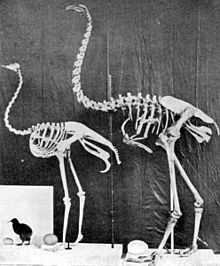- Dinornis
-
Dinornis 
Life restoration of Dinornis novaezealandiae Conservation status Scientific classification Kingdom: Animalia Phylum: Chordata Class: Aves Superorder: Paleognathae Order: Struthioniformes Family: †Dinornithidae Genus: †Dinornis
(Owen, 1843)Species D. novaezealandiae North Island Giant Moa
D. giganteus South Island Giant Moa
D. struthoides
Dinornis new lineage A (undescribed taxon)
Dinornis new lineage B (undescribed taxon)Synonyms Dinoris (lapsus)
"Megalornis" Owen, 1843 (non Gray, 1841: preoccupied, nomen nudum)
Palapteryx (Owen, 1851)The giant moa (Dinornis) is an extinct genus of ratite birds belonging to the moa family. Like all ratites it was a member of the order Struthioniformes. The Struthioniformes are flightless birds with a sternum without a keel. They also have a distinctive palate. It was endemic to New Zealand.
Dinornis may have been the tallest bird that ever lived, with the females of the largest species standing 3.6 m (12 ft)[citation needed] tall, and one of the most massive, weighing 230–240 kg (510–530 lb)[1] or 278 kg (610 lb)[2] in various estimates. Feather remains are reddish brown and hair-like, and apparently covered most of the body except the lower legs and most of the head (plus a small portion of the neck below the head). The feet were large and powerful, and the birds had a long neck that allowed them to reach tall vegetation. In relation to its body, the head was small, with a pointed, short, flat and somewhat curved beak.
The giant moa, along with other moa genera, were wiped out by human colonists who hunted it for food. All taxa in this genus were extinct by 1500 in New Zealand. It is reliably known that the Māori still hunted them at the beginning of the fifteenth century, driving them into pits and robbing their nests. Although some birds became extinct due to farming, for which the forests were cut and burned down and the ground was turned into arable land, the giant moa had been extinct for 300 years prior to the arrival of European settlers.[citation needed]
Contents
Taxonomy
Three species of Dinornis were long considered valid:
- D. giganteus = D. robustus,
- D. novaezealandiae.
They have recently turned out to be males (struthioides) and females of only two species, one each formerly occurring on New Zealand's North Island (D. novaezealandiae) and South Island (D. robustus);[3][4] the North Island specimens, however, contain 3 distinct genetic lineages and may eventually be classified as new species (Baker et al., 2005).
Footnotes
References
- Amadon, D. (1947). "An estimated weight of the largest known bird". Condor 49: 159–164.
- Baker, Allan J.; Huynen, Leon J.; Haddrath, Oliver; Millar, Craig D.; Lambert, David M. (2005). "Reconstructing the tempo and mode of evolution in an extinct clade of birds with ancient DNA: The giant moas of New Zealand" (PDF). Proceedings of the National Academy of Sciences 102 (23): 8257–8262. doi:10.1073/pnas.0409435102. PMC 1149408. PMID 15928096. http://www.pnas.org/content/102/23/8257.full.pdf. Retrieved Feb 14 2011.
- Benes, Josef (1979) Prehistoric Animals and Plants London, UK: Hamlyn p. 191 ISBN 978-0600303411
- Bunce, Michael; Worthy, Trevor H.; Ford, Tom; Hoppitt, Will; Willerslev, Eske; Drummond, Alexei; Cooper, Alan (2003). "Extreme reversed sexual size dimorphism in the extinct New Zealand moa Dinornis". Nature 425 (6954): 172–175. doi:10.1038/nature01871. PMID 12968178.
- Campbell, Jr., K. E.; Marcus, L. (1992). "The relationship of hindlimb bone dimensions to body weight in birds". Papers in avian paleontology honoring Pierce Brodkorb. Science (Natural History Museum of Los Angeles County) (36): 395–412.
- Huynen, Leon J.; Millar, Craig D.; Scofield, R. P.; Lambert, David M. (2003). "Nuclear DNA sequences detect species limits in ancient moa". Nature 425 (6954): 175–178. doi:10.1038/nature01838. PMID 12968179.
- Owen, Richard (1843). "On the remains of Dinornis, an extinct gigantic struthious bird". Proceedings of the Zoological Society of London: 8–10, 144–146.
External links
- South Island Giant Moa. Dinornis robustus. by Paul Martinson. Artwork produced for the book Extinct Birds of New Zealand, by Alan Tennyson, Te Papa Press, Wellington, 2006
Categories:- IUCN Red List extinct species
- Dinornithinae
- Holocene extinctions
- Ratites
- Genera of birds
- Extinct birds of New Zealand
Wikimedia Foundation. 2010.



